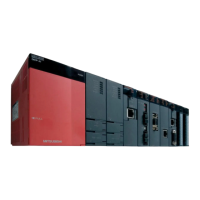14 DIVIDED DATA READ/WRITE FROM/TO BFM INSTRUCTION
14.2 Divided BFM write
687
14
14.2 Divided BFM write
WBFM
This instruction writes data to continuous buffer memory areas in an FX3 series intelligent function module.
■Descriptions, ranges, and data types
■Applicable devices
• This instruction writes (n1) points of buffer memory starting from (s1) inside the intelligent function module number (U/H) to
(s2) in the CPU module. When (n1) exceeds 64 points, it divides and writes by several scans. (64 points are read in one
scan)
• When this instruction is finished normally, instruction execution complete flag (SM8029) turns on. When this instruction is
finished abnormally, instruction execution abnormal end flag (SM8329) turns on.
• When this instruction or the RBFM instruction is executed in the same scan, instruction non-execution flag (SM8328) is set
to on, and execution of such an instruction is paused. When execution of the other target instruction is complete, the
paused instruction resumes.
Ladder diagram Structured text
ENO:=WBFM(EN,UnHn,s1,s2,n1,n2);
Operand Description Range Data type Data type (label)
(U/H) Module number K1 to 16 16-bit unsigned binary ANY16_U
(s1) Head buffer memory number 0 to 32767 16-bit unsigned binary ANY16_U
(s2) Head device number storing data to be written to buffer memory 16-bit signed binary ANY16
(n1) Number of all buffer memory areas to be written 1 to 32768 16-bit unsigned binary ANY16_U
(n2) Not used 16-bit unsigned binary ANY16_U
Operand Bit Word Double word Indirect
specification
Constant Others
X, Y, M, L,
SM, F, B, SB
U\G T, ST,
C, LC
T, ST, C, D,
W, SD, SW, R
U\G Z LC LZ K, H E $
(U/H)
(s1)
(s2)
(n1)
(n2)
M
SM8029
WBFM
(U/H)
(s1) (n1) (n2)
SM8328
M
BFM#(s1)
BFM#((s1)+(n1)-1)
(s2)+(n1)-1
SM8329
M
(s2)
(s2)
Instruction execution complete flag
Instruction non-execution flag
Module number (U/H)CPU module
Write
Instruction execution abnormal end flag
Command
input

